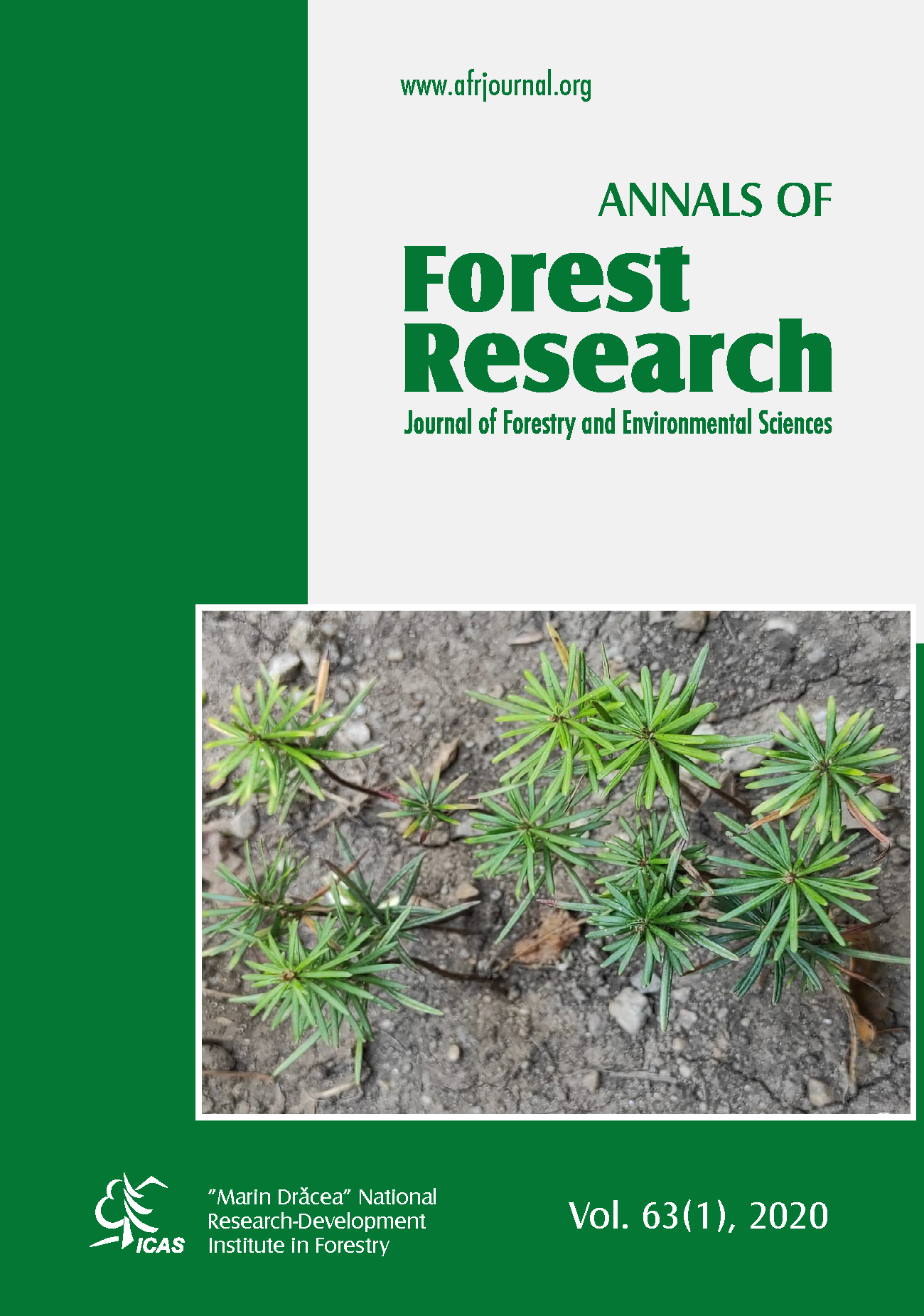Data collection methods for forest inventory: a comparison between an integrated conventional equipment and terrestrial laser scanning
DOI:
https://doi.org/10.15287/afr.2018.1189Keywords:
Field Map system, terrestrial laser scanning, forest inventoryAbstract
This study aims to present a comparison analysis of two data collection methods that can be used in order to obtain reference ground truth data for forestry – a conventional method that uses specific equipment such as Field Map system, caliper and vertex inclinometer and a modern method based on terrestrial laser scanning (TLS) technology. The research was conducted in six circular Permanent Plots (PPs) with an area of 500 squaremeters each, within thinning and selected cuttings stands of sessile oak (Quercus petraea (Matt.) Liebl.), common beech (Fagus sylvatica L.) and Norway spruce (Picea abies L. Karst.), all situated in the Southern Carpathians (Mihăești, Mușeteși and Vidraru Forest Districts). Using the conventional method, the dendrometric tree characteristics such as height, diameter at breast height (dbh) and tree position were directly recorded in thefield. As a modern method for data collection, a Faro Focus3D X 130 HDR terrestrial laser scanning device was used to scan each plot and to extract the dbh and height of the trees. In this regard, two scanning approaches were used - single scan (SS) and multiple scan (MS). In order to compare the two data acquisitions methods, we applied a Strengths, Weaknesses, Opportunities, Threats (SWOT) analysis on the basis of which we could establish the pros and cons of using the two methods. Therefore, one can choose the most advantageous method for obtaining the reference data for forestry, in terms of equipment acquisition cost, personnel skills and qualifications, data collection working time, accuracy of the data recorded, post processing time, labor costs. Although the use of TLS in forest inventory is a technology with high potential, further investigations need to be done, especially in the case of automatic extraction of the tree height. For accurate reference ground data for forest inventory purposes, we still recommend using the conventional methods although they are time consuming.References
Aschoff T., Spiecker H., 2004. Algorithms for the automatic detection of trees in laser scanner data. The International Archives of Photogrammetry, Remote Sensing and Spatial Information Sciences, Freiburg, Deutschland, Vol. XXXVI, Part 8/ W2:. 66- 70. Asner G.P, Mascaro J., 2014. Mapping tropical forest carbon: Calibrating plot estimates to a simple LiDAR metric. Remote Sensing of Environment 140: 614–624. DOI: 10.1016/j.rse.2013.09.023 Bauwens S., Bartholomeus H., Calders K., Lejeune P., 2016. Forest Inventory with Terrestrial LiDAR: A Comparison of Static and Hand-Held Mobile Laser Scanning." Forests 7, no. 6: 1-17. DOI: 10.3390/f7060127 Bernasconi L., Chirici G., Marchetti, M., 2017. Biomass estimation of xerophytic forests using visible aerial imagery: Contrasting single-tree and area-based approaches. Remote Sensing, 9(4) :1-12. DOI: 10.3390/rs9040334 Blair J.B., Rabine D.L., Hofton M.A., 1999. The Laser Vegetation Imaging Sensor: a medium-altitude, digitisation-only, airborne laser altimeter for mapping vegetation and topography. ISPRS Journal of Photogrammetry and Remote Sensing 54: 115–122. DOI: 10.1016/S0924-2716(99)00002-7 Boehm H.D., Liesenberg V., Limin S.H., 2013. Multi-Temporal Airborne LiDAR-Survey and Field Measurements of Tropical Peat Swamp Forest to Monitor Changes. IEEE Journal of Selected Topics in Applied Earth Observations and Remote Sensing 6: 1524–1530. DOI: 10.1109/JSTARS.2013.2258895 Brolly G., Kiraly G., 2009. Algorithms for stem mapping by means of terrestrial laser scanning. Acta Silvatica et Lignaria Hung. 5: 119–130. Brovkina O., Cienciala E., Surový P., Janata P., 2018. Unmanned Aerial Vehicles (UAV) for Assessment of Qualitative Classification of Norway Spruce in Temperate Forest Stands. Geo-Spatial Information Science 21(1): 12–20. DOI: 10.1080/10095020.2017.1416994 Brovkina O., Novotny J., Cienciala E., Zemek F., Russ R., 2017. Mapping forest aboveground biomass using airborne hyperspectral and LiDAR data in the mountainous conditions of Central Europe. Ecological Engineering, 100: 219–230. DOI: 10.1016/j.ecoleng.2016.12.004 Cabo C., Ordó-ez C., López-Sánchez C.A., Armesto J., 2018. Automatic dendrometry: Tree detection, tree height and diameter estimation using terrestrial laser scanning. International Journal of Applied Earth Observation and Geoinformation, 69: 164-174. DOI: 10.1016/j.jag.2018.01.011 Fleck S., Mölder I., Jacob M., Gebauer T., Jungkunst H.F., Leuschner C., 2011. Comparison of conventional eight-point crown projections with LIDAR-based virtual crown projections in a temperate old-growth forest. Annals of Forest Science 68: 1173–1185. DOI: 10.1007/s13595-011-0067-1 Grudnicki F., 2004. Coeficientul de zvelteţe şi stabilitatea individuală a arborilor de molid. Bucovina Forestieră 12(1-2): 75-87. Huang H., Li Z., Gong P., Cheng X., Clinton N., Cao C., Ni W., Wang L., 2011. Automated methods for measuring DBH and tree heights with a commercial scanning lidar. Photogrammetric engineering and remote sensing. 77: 219–227. DOI: 10.14358/PERS.77.3.219 Keenan R.J., Reams G.A., Achard F., de Freitas J.V., Grainger A., Lindquist E., 2015. Dynamics of global forest area: results from the FAO global forest resources assessment 2015. For. Ecol. Manage. 352: 9–20. DOI: 10.1016/j.foreco.2015.06.014 Liang X., Hyyppä J., 2013. Automatic stem mapping by merging several terrestrial laser scans at the feature and decision levels. Sensors 13: 1614–1634. DOI: 10.3390/s130201614 Liang X., Kankare V., Hyyppä J., Wang Y., Kukko A., Haggrén H., Yu X., Kaartinen H., Jaakkola A., Guan F., Holopainen M., Vastaranta, M., 2016. Terrestrial laser scanning in forest inventories. ISPRS Journal of Photogrammetry and Remote Sensing, 115: 63–77. DOI: 10.1016/j.isprsjprs.2016.01.006 Lovell J.L., Jupp D.L.B., Newnham G.J., Culvenor D.S., 2011. Measuring tree stem diameters using intensity profiles from ground-based scanning lidar from a fixed viewpoint. ISPRS Journal of Photogrammetry and Remote Sensing 66: 46–55. DOI: 10.1016/j.isprsjprs.2010.08.006 MacDicken K.G., 2015. Global forest resources assessment 2015: What, why and how? For. Ecol. Manage. 352: 3–8. DOI: 10.1016/j.foreco.2015.02.006 Maas H.G., Bienert A., Scheller S., Keane E., 2008. Automatic forest inventory parameter determination from terrestrial laser scanner data, International Journal of Remote Sensing, 29:5: 1579-1593 DOI: 10.1080/01431160701736406 Newnham G., Armstrong J., Muir J., Goodwin N., Culvenor D., Pushel P., Nystrom M., Johansen K., Tindall D. 2011. Evaluation of Terrestrial Laser Scanners for Measuring Vegetation Structure. CSIRO Australia. Sustainable Agriculture Flagship, Manuscript ID: EP 124571 Niska H., Skon J., Packalen P., Tokola T., Maltamo M., Kolehmainen M., 2010. Neural Networks for the Prediction of Species-Specific Plot Volumes Using Airborne Laser Scanning and Aerial Photographs. IEEE Transactions on Geoscience and Remote Sensing 48: 1076–1085. DOI: 10.1109/TGRS.2009.2029864 Olofsson K., Holmgren J., Olsson H., 2014. Tree stem and height measurements using terrestrial laser scanning and the RANSAC algorithm. Remote Sens. 6: 4323–4344. DOI: 10.3390/rs6054323 Othmani, A., Piboule, A., Krebs, M., Stolz, C., and Lew Yan Voon, L. (2011) Towards automated and operational forest inventories with t-lidar. 11th International Conference on LiDAR Applications for Assessing Forest Ecosystems (SilviLaser 2011), Oct 2011, Hobart, Australia. https://hal.archives-ouvertes.fr/hal-00646403 Pueschel P., Newnham G., Rock G., Udelhoven T., Werner W., Hill J., 2013. The influence of scan mode and circle fitting on tree stem detection, stem diameter and volume extraction from terrestrial laser scans. ISPRS Journal of Photogrammetry and Remote Sensing 77, 44–56. DOI: 10.1016/j.isprsjprs.2012.12.001 Simonse M., Aschoff T., Spiecker H., Thies M., 2003. Automatic Determination of Forest Inventory Parameters Using Terrestrial Laser Scanning. In Proceedings of the ScandLaser Scientific Workshop on Airborne Laser Scanning of Forests 251–257. Stanley T., 2013. Assessment of the FARO 3D focus laser scanner for forest inventory. BSc thesis, Faculty of Health, Engineering and Sciences, University of Southern Queensland, Toowooba, QLD, Australia, 86 p. http://eprints.usq.edu.au/id/eprint/24708 Tockner A., Leisch F., Nothdurft A., 2017. Automatic mapping of forest stands based on three-dimensional point clouds derived from terrestrial laser-scanning, Forests, 8(8): 1–19. Trumbore S., Brando P., Hartmann H., 2015. Forest health and global change. Science 349 (6250): 814–818. DOI: 10.1126/science.aac6759 Tubiello F.N., Salvatore M., Ferrara A.F., House J., Federici S., Rossi S., Prosperi P., 2015. The contribution of agriculture, forestry and other land use activities to global warming, 1990–2012. Global Change Biology 21 (7), 2655–2660. DOI: 10.1111/gcb.12865 Vopěnka P, Černý M (2006). GIS aided Statistical Forest Inventory in Transcarpathia, Ukraine. ArcNews, 27(4). Wang P., Bu G., Li R., Zhao R., 2017. Automated Low-cost Terrestrial Laser Scanner for Measuring Diameters at Breast Height and Heights of Forest Trees. arXiv preprint arXiv:1702.02235. Watt P.J., Donoghue D.N.M., 2005. Measuring forest structure with terrestrial laser scanning. International Journal of Remote Sensing, 26(7): 1437-1446. DOI: 10.1080/01431160512331337961 Weiß J., 2009. Application and statistical analysis of terrestrial laser scanning and forest growth simulations to determine selected characteristics of douglas-fir stands. Folia Forestalia Polonica 51(2): 123–137.
Downloads
Published
Issue
Section
License
All the papers published in Annals of Forest Research are available under an open access policy (Gratis Gold Open Access Licence), which guaranty the free (of taxes) and unlimited access, for anyone, to entire content of the all published articles. The users are free to “read, copy, distribute, print, search or refers to the full text of these articles”, as long they mention the source.
The other materials (texts, images, graphical elements presented on the Website) are protected by copyright.
The journal exerts a permanent quality check, based on an established protocol for publishing the manuscripts. The potential article to be published are evaluated (peer-review) by members of the Editorial Board or other collaborators with competences on the paper topics. The publishing of manuscript is free of charge, all the costs being supported by Forest Research and Management Institute.
More details about Open Access:
Wikipedia: http://en.wikipedia.org/wiki/Open_access




